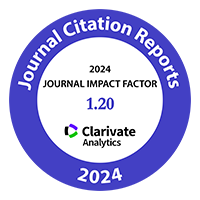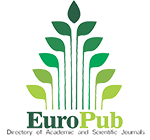Preventive and curative effects of native yeasts on different Botrytis cinerea strains in “Superior Seedless” (Vitis vinifera L.) table grape cultured in Argentina
DOI:
https://doi.org/10.48162/rev.39.155Palabras clave:
preventivo, curativo, levaduras enológicas, Botrytis cinerea, uva de mesa, modos de acciónResumen

The fermenting grape must is a dynamic, stressful, and selective habitat where many yeast species compete. Specific yeasts isolated from this habitat can play a fundamental role in table grape biocontrol of fungal diseases. The present study evaluated 225 grapevine yeasts against four Botrytis cinerea strains isolated from “Superior Seedless” grapes, considering the possible antifungal action mechanisms. Eighteen enological yeasts (13 Saccharomyces and 5 non- Saccharomyces) showed preventive antifungal activity against the four native B. cinerea strains, with disease severity varying between 0 and 49.91%. These 18 strains also presented curative activity against at least one of the B. cinerea strains assayed (severity values between 0 and 45.99%). Considering action mechanisms, thirteen yeast strains inhibited mycelial growth of at least one B. cinerea strain during dual plating (antibiosis), “killer” activity, and volatile antifungal assays. Our results showed that 7 yeast strains affected conidial germination (CG) and germinal tube length (GTL) of at least one B. cinerea isolate. Two yeast strains occupied the same niche as 4 B. cinerea strains (NOI values > 0.90). All yeast strains exhibited at least two inhibitory action mechanisms against gray rot, except for BSc140 with one mechanism. The possibility of more than one mechanism per yeast strain makes biocontrol an effective tool to prevent and cure gray rot in table grapes.
Highlights:
- We evaluated 225 native grapevine yeasts against four Botrytis cinereastrains isolated from “Superior Seedless” grapes, considering the possible antifungal action mechanisms.
- Saccharomyces (13) and 5 non- Saccharomyces(5) strains showed preventive antifungal activity against native cinerea strains (4).
- Some grapevine yeasts (10 Saccharomycesy 4 non- Saccharomyces) presented curative activity against cinerea strains.
- Grapevine yeasts, with preventive and curative activity, presented different antifungal mechanisms against cinerea.
Descargas
Citas
Abbey, J. A.; Percival, D.; Abbey, L.; Asiedu, S. K.; Prithiviraj, B.; Schilder, A. 2018. Biofungicides as an alternative to synthetic fungicide control of grey mould (Botrytis cinerea) - prospects and challenges. Biocontrol Science and Technology. 29: 3.
CASAFE (Cámara de Sanidad Agropecuaria y Fertilizantes). 2024. Guía fitosanitaria. Argentina. https://guiaonline.casafe.org/
Da Cunha, T.; Ferraz, L. P.; Wehr, P. P.; Kupper, K. C. 2018. Antifungal activity and action mechanisms of yeasts isolated from citrus against Penicillium italicum. International Journal of Food Microbiology. 276: 20-27.
Elad, Y.; Vivier, M.; Fillinger, S. 2015. Botrytis: the good, the bad, and the ugly. In: Fillinger S.; Elad Y.; Vivier M. (Eds.), Botrytis-the Fungus, the pathogen and its management in agricultural systems. Springer, Heidelberg, Germany. 1-15.
Ferraz, L. P.; da Cunha, T.; da Silva, A. C.; Kupper, K. C. 2016. Biocontrol ability and putative mode of action of yeasts against Geotrichum citri-aurantii in citrus fruit. Microbiol. Res. 188: 72-79.
INV (Instituto Nacional de Vitivinicultura). 2022. Exportaciones. Información: estadísticas informes. Argentina. https://www.argentina.gob.ar/inv/vinos/estadisticas
Korres, A. M. N.; Buss, D. S.; Ventura, J. A.; Fernández, P. M. B. 2011. Candida krusei and Kloeckera apis inhibit the causal agent of pineapple fusariosis, Fusarium guttiforme. Fungal Biol. 115: 1251-1258.
Lopes, M. R.; Klein, M. N.; Ferraz, L. P.; Silva, A. C.; Kupper, K. C. 2015. Saccharomyces cerevisiae: a novel and efficient biological control agent for Colletotrichum acutatum during pre-harvest. Microbiol. Res. 175: 93-99.
Madbouly, A. K.; Kamal, A. M.; Ismail, M. I. 2020. Biocontrol of Monilinia fructigena, the causal agent of brown rot of apple fruit, by using endophytic yeasts. Biological Control. 144: 104239.
Magliani, W.; Conti, S.; Travassos, L. R.; Polonelli, L. 2008. From yeast killer toxins to antibiobodies and beyond. FEMS Microbiol Lett. 288: 1-8.
Mari, M.; Bautista-Baños, S.; Sivakumar, D. 2016. Decay control in the postharvest system: role of microbial and plant volatile organic compounds. Postharvest Biol. Technol. 122: 70-81.
Muñoz, C.; Gomez, S.; Oriolani, E.; Combina, M. 2010. Genetic characterization of grape vine-infecting Botrytis cinerea isolates from Argentina. Revista Iberoamericana de Micología. 27: 66-70.
Nally, M. C.; Pesce, V. M.; Maturano, Y. P.; Muñoz, C. J.; Combina, M.; Toro, M. E.; Castellanos de Figueroa, L. I.; Vazquez F. 2012. Biocontrol of Botrytis cinerea in table grapes by non-pathogenic indigenous Saccharomyces cerevisiae yeast isolated from viticultural environments in Argentina. Post. Biology and Technology. 64: 40-48.
Nally, M. C.; Pesce, V. M.; Maturano, Y. P.; Rodriguez Assaf, L. A.; Toro, M. E.; Castellanos de Figueroa, L. I.; Vazquez, F. 2015. Antifungal modes of action of Saccharomyces and other biocontrol yeasts against fungi isolated from sour and grey rots. Int J Food Microbiol. 204: 91-100.
Parafati, L.; Vitale, A.; Restuccia, C.; Cirvilleri, G. 2015. Biocontrol ability and action mechanism of food-isolated yeast strains against Botrytis cinerea causing table g. Food Microbiol. 47: 85-92.
Pesce, V. M.; Nally, M. C.; Carrizo, G.; Rojo, C.; Pérez, B.; Toro, M. E.; Castellanos de Figueroa, L.; Vazquez, F. 2018. Antifungal activity of native yeasts from different microenvironments against Colletotrichum gloeosporioides on ripe olive fruits, Biological Control. 120: 43-51.
Qin, X. J.; Xiao, H. M.; Xue, C. H.; Yu, Z. F.; Yang, R.; Cai, Z. K. 2015. Biocontrol of gray mold in grapes with the yeast Hanseniaspora uvarum alone and in combination with salicylic acid or sodium bicarbonate. Postharvest Biol. Tec. 100: 160-167.
Querol, A.; Fernandez-Espinar, M. T.; Olmo, M. L.; del Barrio, E. 2003. Adaptive evolution of wine yeast. Int. J. Food Microbiol. 86: 3-10.
Sepúlveda, X.; Vargas, M.; Vero, S.; Zapata, N. 2023. Indigenous Yeasts for the Biocontrol of Botrytis cinerea on Table Grapes in Chile. J. Fungi. 9: 557.
Spadaro, D.; Droby, S. 2016. Development of biocontrol products for postharvest diseases of fruit: the importance of elucidating the mechanisms of action of yeast. Trends in Food Science and Technology. 47: 39-49.
Varela Pardo, R. A.; López Lastra, C. C.; Manfrino, R. G.; Balcazar, D.; Mónaco, C.; Wright, E. R. 2024. Selection of fungal isolates from Buenos Aires, Argentina, as biological control agents of Botrytis cinerea and Sclerotinia sclerotiorum. Revista de la Facultad de Ciencias Agrarias. Universidad Nacional de Cuyo. Mendoza. Argentina. 56(2): 72-86. DOI: https://doi.org/10.48162/rev.39.138.
Vilaplana, R.; Cifuentes, C.; Vaca, L.; Cevallos-Cevallos, J. M.; Valencia-Chamorro, S. 2020. The curative activity of possible biocontrol agents in the postharvest of yellow pitahaya and organic banana. Postharvest Biology and Technology. 159-111030.
Wilson, M.; Lindow, S. 1994. Ecological similarity and coexistence of epiphytic ice-nucleating Pseudomonas syringae strains and non-ice-nucleating biological control agent. Applied and Environmental Microbiology. 60: 3128-3137.

Descargas
Publicado
Cómo citar
Número
Sección
Licencia
Derechos de autor 2018 Revista de la Facultad de Ciencias Agrarias UNCuyo

Esta obra está bajo una licencia internacional Creative Commons Reconocimiento-NoComercial-CompartirIgual 3.0.
Aquellos autores/as que tengan publicaciones con esta revista, aceptan las Políticas Editoriales.












.jpg)




